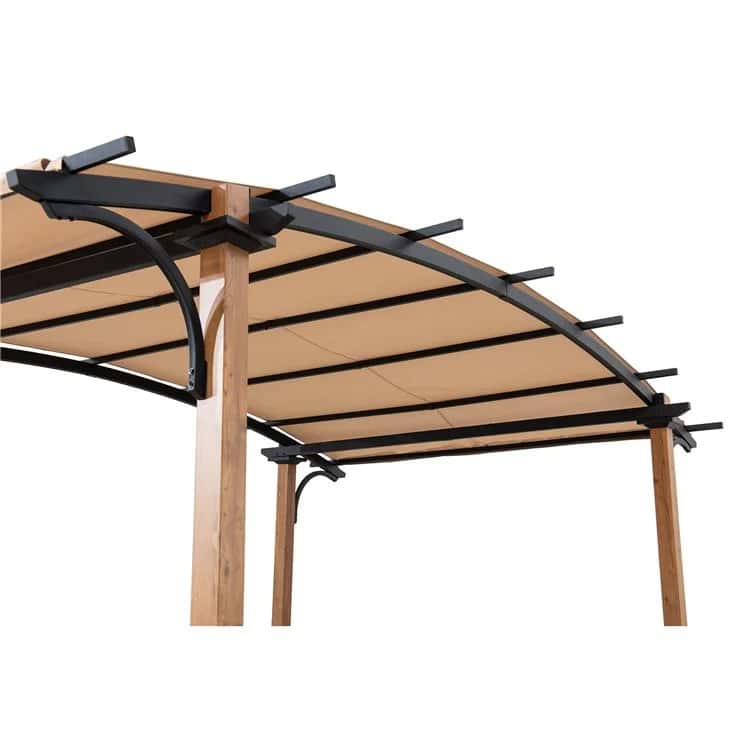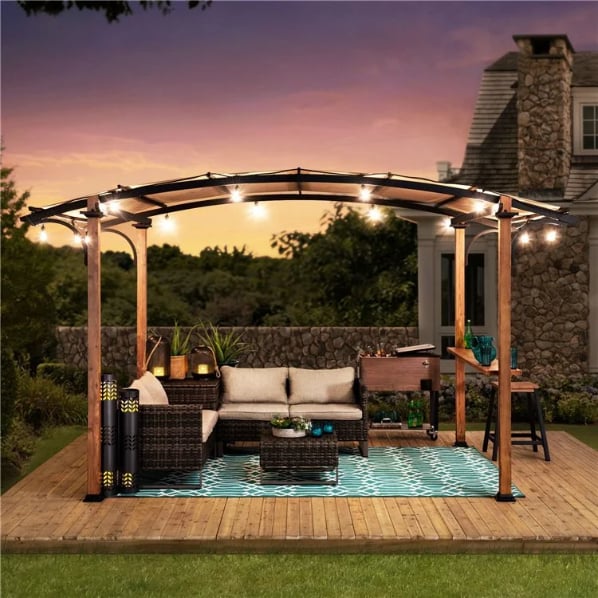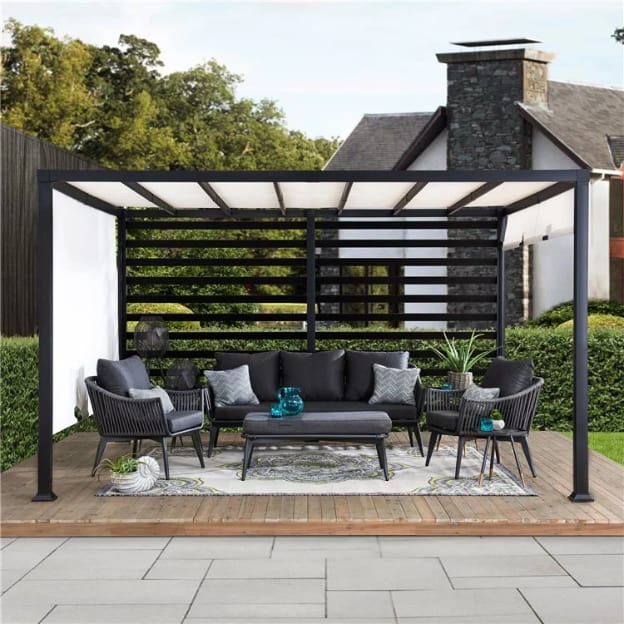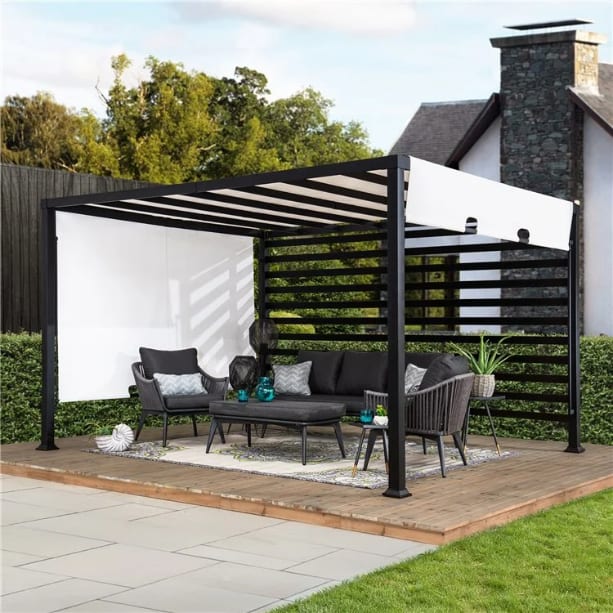Jump to:
A pergola — a word that might sound familiar but often leaves people wondering, “What exactly is it?” It’s not quite a garden gazebo or a patio cover, but something in between. In this guide, we’ll take a closer look at this structure and how you might want to use one in your outdoor space. Keep reading!
A Brief History
Pergolas have been around for a really long time. Back then, they were used in gardens to provide shade and support climbing plants like vines. These early pergolas were often made of stone or wood and had simple designs.
As time went on, pergolas evolved and spread to different parts of the world. In Asia, for instance, they became popular in traditional Japanese houses and gardens. Known as “engawa“, these structures were used as walkways or sitting areas.
In modern times, pergolas have become even more versatile, coming in all shapes and sizes. People use them for hosting BBQ parties, growing grapes for making wine and more. Today, you’ll see pergolas making outdoor spaces nicer and more useful across the globe.
Structure of a Pergola

A pergola has a simple shade structure made up of a few key parts. First, there are vertical posts that hold everything up. These posts are usually set into the ground or attached to a deck or patio. Then, there are horizontal beams that connect the posts at the top, forming the roof of the pergola. These beams can be spaced closely together or farther apart, depending on the design. There are also thin beams that go across, giving more shade and support.
When it comes to materials, wood is a popular choice because it’s sturdy and looks nice in outdoor settings. Cedar and redwood are common types, as they’re naturally resistant to rot and insects. Another option is steel, which is strong and durable. Steel pergolas can have a more modern or industrial look. Moreover, they’re often coated with a protective finish, e.g., powder-coated, to prevent rust. To give you an idea, have a look at this Sunjoy Oeta Steel Pergola.
Both wood and steel can be painted or stained to match your outdoor decor or left natural for a rustic feel.
Shapes and Features

Pergolas come in different shapes and styles, each with its own unique features. You might see a classic arched pergola, which has a curved roof that adds elegance to the structure. These are often made with a wood finish, giving them a natural and inviting look.
Alternatively, you might find a rectangular one, which has a simple and clean design. These are great for creating a defined outdoor space, such as a dining or seating area. Some pergolas even have a flat roof, providing a modern and minimalist aesthetic. These are often seen in contemporary designs, complementing sleek garden furniture and decor.
Additionally, there are pergolas with lattice sides. Such features allow climbing plants to grow and create a lush green canopy overhead. These add a touch of nature while still providing shade and privacy.
Pergola vs Gazebo

Pergolas and garden gazebos are outdoor things that make your yard look nice, but they’re not the same. Pergolas usually have an open roof made of beams and posts, providing partial shade. They’re perfect for making a cosy place to sit or walk through, especially when you grow plants on them.
Gazebos, on the other hand, have a solid roof and sides, protecting you completely from sun or rain. They’re more like little garden rooms, great for eating or relaxing in. So, while both make your yard pretty, they do it in different ways, depending on what you want for your outdoor space.
When it comes to what they’re made of, both pergolas and gazebos can be built from wood. But, when you think of a pergola, you may picture something more simple and natural-looking. Wooden pergolas fit well with gardens and can be coloured or painted to match your outdoor style. Wooden gazebos, though, often have fancier wooden parts. For one, pretty designs are carved into the pillars or extra decorative details. This makes them look more elegant and adds a special touch to your garden area. So, while both use wood, pergolas have a simpler vibe, while gazebos are more decorative.
Tip: Read our ‘What’s the Difference Between a Gazebo and Pergola?’ next to learn more.
Why Should You Have a Pergola

Adding a pergola to your outdoor space offers numerous advantages:
- Enhanced aesthetics: Pergolas add a stylish and inviting structure to outdoor spaces. They serve as focal points, enhancing the visual appeal of your landscaping. Their design can complement various outdoor styles, from rustic to modern.
- Providing shade in the garden: Pergolas offer a shaded area. This makes your outdoor space more comfortable, especially during sunny days. The open-roof design allows sunlight to filter through. Even better while still providing protection from direct sunlight.
- Creating functional outdoor living areas: Pergolas define outdoor spaces. They provide designated areas for various activities, such as dining, entertaining, or relaxing. Seating and outdoor lighting additions allow you to create the ideal retreat.
- Increasing property value: Pergolas can increase home value by enhancing its curb appeal. A well-designed and maintained pergola adds to the overall appeal of your property. This, overall, makes it more desirable to potential buyers.
Round-up
Pergolas make your yard look nicer and give you a cool place to hang out outside. They’re great for eating, having friends over, or just chilling outside. Adding one can make your home worth more, too. So, if you want to make your outdoor space more inviting and enjoyable, think about adding one!
Explore Garden Buildings Direct for our wide range of outdoor shade options. Take advantage of our special deals on gazebos and patio parasols.
Up next on your reading list: How to Decorate a Gazebo or Pergola





